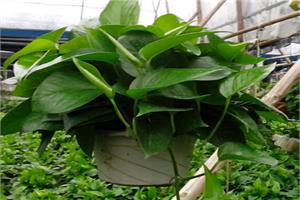Green pineapple is divided into several kinds of green pineapple.
Green pineapple is a kind of evergreen plant all the year round, which is good for watching and purifying the air. You can cultivate it in soil or find a beautiful glass and pour it into clean water to feed it. So green pineapple is basically the best plant, very suitable for lazy people to plant, so how many kinds of green radish are there?

There are many kinds of green pineapple, if you want to cultivate green pineapple, you can know about the species of green pineapple in advance, so that you can choose the kind that suits you to grow. Next, let's take a look at how many kinds of green turnips there are.
Green leaves and green apples: the leaves are all turquoise, without patterns and colors.
Yellow leaf green apple (Pueraria lobata): the leaves are light golden yellow and the leaves are thin.
Mosaic green pineapple: mosaic green pineapple refers to the different color markings on the leaves of green radish. According to the color and characteristics of the pattern, three varieties have been found.
Pueraria lobata (E.A.): leaves with milky white markings, stronger than the original variety
Pueraria lobata (E.A.): irregular yellow stripes on leaves
Three-color Pueraria lobata (E.A.): green leaves with yellow milky white markings
Dotted vine: velvety green leaves, covered with silver-green patches or spots.
The above are the types of green pineapple, you can choose to cultivate according to your favorite type, and the following editor will add some green planting methods for you.
Intercalation method
Green pineapple is usually propagated by cuttings. Select robust green radish vine in late spring and early summer, cut the branches from 15 to 30 centimeters, remove the leaves from the base 1 to 2, be careful not to hurt the air root, and then insert into the plain sand or cinder, the depth is 1gamma 3 of the cuttings, drench enough water to place in the shade, spray water to the leaves every day or cover with plastic film to moisturize, as long as the environment is not less than 20 ℃, the survival rate is more than 90%.
The specific methods of interpolation are as follows:
1. Selection and treatment of cuttings
Cuttings should choose semi-lignified branches with strong growth and no diseases and insect pests, cut into 10-13 cm long, cut into oblique notches, leave 2-3 leaves at the upper end, and cut off half of the leaves, so as to reduce water evaporation and facilitate the survival of cuttings.
2. Insert matrix
The loam or sandy soil with high humus content, which is loose and permeable, good drainage and high humus content, is required to be inserted into the substrate. It is best to use vermiculite, so that the root is fast and the survival rate is high. Disinfect the soil with 2% formalin or 5% potassium permanganate before insertion.
3. Insertion method
The lower end of the prepared cuttings was quickly dipped in ABT rooting powder or indolebutyric acid, and then inserted into the prepared substrate, buried in soil and watered thoroughly, so that the cuttings were in close contact with the substrate, and then covered with plastic film.
4. Plug-in management
(1) pay attention to keeping the soil moist and higher air temperature after insertion. The soil moisture is about 50%, while the air humidity is 80% and 90%.
(2) the shade degree of the shade canopy is kept at about 80% at the initial stage of planting, which can not only prevent strong direct sunlight, but also ensure sufficient scattered light, so as to facilitate photosynthesis and rooting of leafy cuttings.
(3) through the above treatment, it is generally basic to take root after 20 days, and the film can be removed to increase the light. at the same time, attention should be paid to foliar spray and shading on sunny days in summer, cold prevention in winter, and normal management in the basin about 10 days after rooting.
The above is the introduction of green pineapple species and cultivation methods. If you like green pineapple, you will immediately plant a pot. Watching green pineapple grow every day will make you feel better.
- Prev

How to raise a large-leaf umbrella the culture method of a large-leaf umbrella
How to raise a large-leaf umbrella the culture method of a large-leaf umbrella
- Next

How much is the potted green radish? it is not expensive, but it should be well preserved.
How much is the potted green radish? it is not expensive, but it should be well preserved.
Related
- Wuhan Hospital Iron Tree Blooming Result Was Instantly Frightened by the Gardener Master
- Which variety of camellia is the most fragrant and best? Which one do you like best?
- What is the small blue coat, the breeding methods and matters needing attention of the succulent plant
- Dormancy time and maintenance management of succulent plants during dormancy
- Minas succulent how to raise, Minas succulent plant pictures
- What are the varieties of winter succulent plants
- How to raise succulent plants in twelve rolls? let's take a look at some experience of breeding twelve rolls.
- Attention should be paid to water control for succulent plants during dormant period (winter and summer)
- Watering experience of twelve rolls of succulent plants
- Techniques for fertilizing succulent plants. An article will let you know how to fertilize succulent plants.

